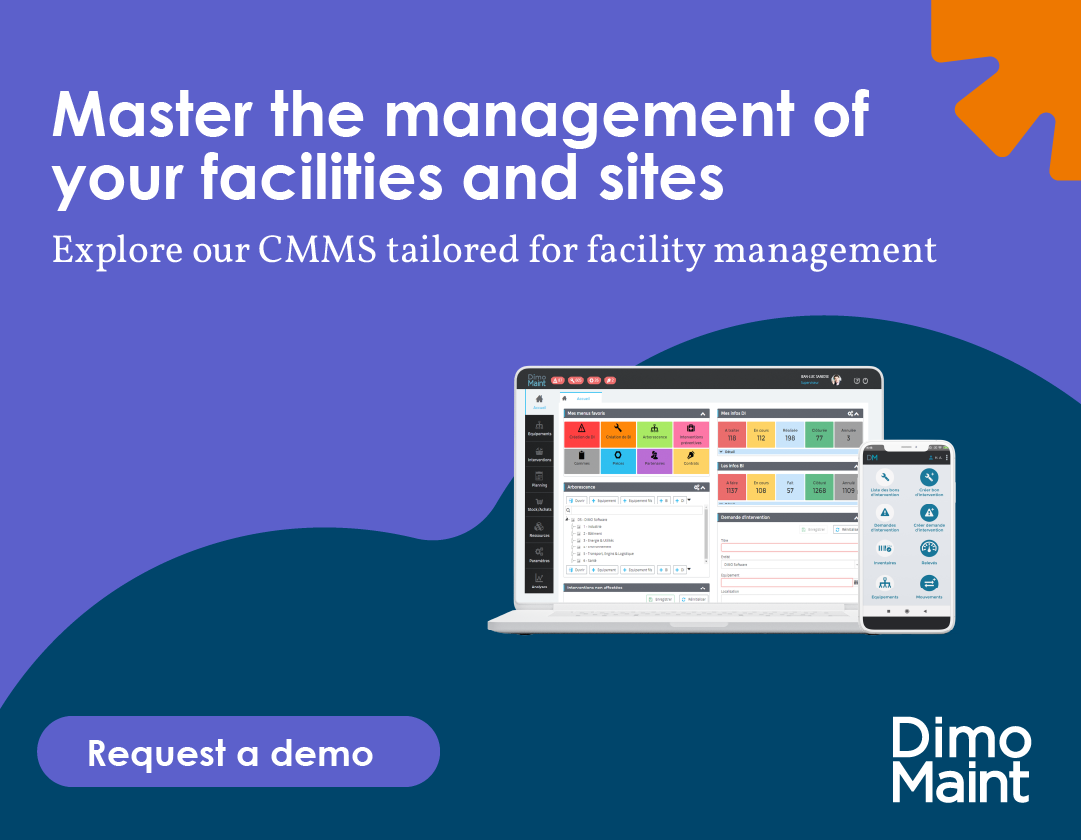Maintaining buildings and equipment in the education sector ensures a safe, functional, and conducive learning environment. Therefore, it is a priority for schools, universities, and educational groups. Maintenance covers several aspects: from monitoring equipment to overseeing more intangible assets, Facility Management in education requires a meticulous approach and suitable tools.
The challenge of controlled maintenance in the educational environment

- infrastructure: this term can refer to educational spaces in the strict sense (classrooms, laboratories, libraries, various activity areas…) or support structures such as cafeterias, offices, restrooms, heating/cooling systems, and various safety systems,
- pedagogical equipment: various materials, demonstration or measurement devices, books… educational equipment is omnipresent within the infrastructure
- computer systems today support a large part of school activities. They also contribute to ensuring the safety of the institutions (alarms, cameras…)
These “facilities,” diverse as they are, call for precise maintenance, governed by different wear and tear, needs, and standards. For example, schools must ensure that computer equipment is up-to-date in terms of security, but also accessible at all times to students and staff. The maintenance of school buildings also raises questions about cost or flexibility, as facility management affects space management and configuration and the achievement of energy savings.
For institutions, it’s about keeping an eye on all the equipment and intelligently coordinating maintenance operations to never hinder learning. Safety and accessibility by occupants are the priorities of school building maintenance.
How to improve the monitoring and management of maintenance in the educational setting?
To meet the high legal standards especially prevalent in school environments, being methodical is indispensable. Precise facility management steps will be defined, such as:
Implementing a detailed inventory of equipment

The inventory is an essential first step to improve the management of school building maintenance. Understanding the nature, quantity, and location of each asset allows for covering every aspect of a school’s maintenance. An overview also means anticipation: with high occupancy rates in educational institutions, preparing maintenance in advance is indispensable.
Scheduling regular inspections
Regular surveillance of school equipment and facilities is essential for detecting potential issues before they become critical. A preventive maintenance approach is meant to relieve school managers of part of their workload and enable them to focus on the often heavy internal organization. By identifying anomalies as they arise, establishments can avoid major disruptions and also extend the life of their equipment—an important factor in savings, both in terms of cost and effort.
Deploying a CAFM/CMMS software
Directly related to this search for anticipation, preventive maintenance involves regular maintenance tasks to prevent breakdowns. This maintenance can be implemented by establishing a preventive maintenance schedule and the partial automation of tasks. Adopting a CAFM allows for flexibility, even with limited resources.
Using Computer-Aided Facility Management (CAFM) software for the maintenance of facilities and infrastructure
Among the Facility Management software, CAFM/CMMS holds a prominent place. Computer-aided maintenance management centralizes all the vital information for equipment monitoring. But the software goes further with the planning of interventions, the optimization of resources, and other features such as energy and space management. The CAFM thus streamlines the processes of school maintenance management and ensures actions are always in the best interest of the end-user.
The benefits of using a CAFM for managing regular and complex maintenance tasks
The benefits of using CAFM software for educational institutions are numerous. Among the most notable are:
Improved resource management
CAFM contributes to the productivity of educational institutions: the software enables the optimization of intervention scheduling, reduces downtime of school equipment, and maximizes the productivity of maintenance teams. The result is a facility with maximum accessibility, where malfunctions do not impede the comfort of learning. In terms of management, CAFM provides significant time and cost savings. The software enables the streamlining of often limited resources, which can be allocated more intelligently.
Strategic planning of interventions
CAFM features advanced functionalities for planning and tracking tasks. Schools can thus reason on the scale of entire spaces and ensure their availability throughout the building maintenance process. With CAFM, they can prioritize work based on its impact on school activities and better anticipate long-term needs.
Understanding internal processes and needs
Beyond reactivity, CAFM offers a valuable overview of all equipment, infrastructure, and computer hardware in an institution. This way, all assets are considered, with their interdependencies and the processes linked to them. The maintenance of schools becomes more global and internal needs are better understood. CAFM provides schools with a deeper understanding of their operations and concrete tools for improvement.
The safety of all equipment
Safety is a major criterion for the maintenance of school facilities. CAFM assists managers with rigorous standards monitoring, flawless traceability, and a significant preventive dimension important for the daily protection of occupants. From preventive safety measures (alarms, access systems, cameras) to the sanitation of spaces, CAFM allows for covering safety in the most comprehensive way possible.
Looking for maintenance software to optimize your Facility Management?
Case studies and best practices
In 2020, the RCSI, a major surgical training body in Ireland, adopted DimoMaint for the management of its 30 sites, including a university and an international research institution. Thanks to the CAFM, RCSI significantly improved the management of its facilities, introduced a strong preventive dimension, and reinforced information sharing by its teams.
At the heart of these benefits was an increased ability to collaborate through CAFM, which RCSI lacked before. The capability for facility management teams to connect to the mobile application and continuous collaboration between the stakeholders in school maintenance played a key role in improving maintenance.
For RCSI, the CAFM also meant a digital transformation, which brought crucial precision to maintenance operations. This resulted in a notable optimization of resources, improved data security, and better regulatory compliance. CAFM was able to adapt to the specific profile of the institution and freed managers from significant administrative constraints.
Discover the full testimonial from the Royal College of Surgeons in Ireland: “Managing 30 university buildings in Ireland with DimoMaint FM”.
Like this case study, proper maintenance of buildings and equipment allows the educational sector to focus its efforts on welcoming students and accessibility. To adopt a tailored strategy, it is essential to have powerful tools like CAFM software. Offering a preventive dimension that manual management does not provide, computerized maintenance ensures a safe school environment and enhances long-term practices.





